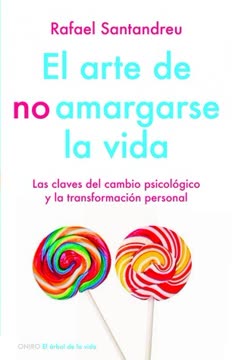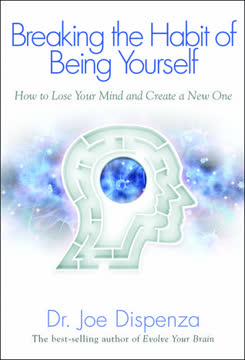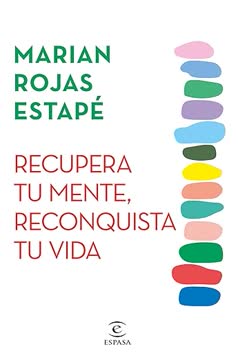النقاط الرئيسية
1. السعادة خيار: تعلّم كيف تفسر الواقع بإيجابية
السعادة لا تكمن فيما يحدث لنا، بل في كيفية تفسيرنا لما يحدث.
الإدراك يشكّل الواقع. تفسيرنا للأحداث، وليس الأحداث نفسها، هو ما يحدد سعادتنا. هذه الفكرة، المستندة إلى علم النفس المعرفي، تشير إلى أنه من خلال تغيير أنماط تفكيرنا، يمكننا أن نؤثر بشكل كبير على صحتنا العاطفية.
خطوات عملية للتفسير الإيجابي:
- مارس الامتنان يوميًا
- ابحث عن الجوانب المضيئة في المواقف الصعبة
- تحدَّ الحديث السلبي مع الذات
- ركّز على ما يمكنك التحكم به
- نمِّ عقلية النمو والتطور
باختيارنا الواعي لرؤية تحديات الحياة كفرص للنمو والتعلم، نزيد من مرونتنا ورضانا العام عن الحياة. هذا لا يعني تجاهل المشاكل، بل التعامل معها بعقلية بناءة تشجع على حل المشكلات وتطوير الذات.
2. الكورتيزول: هرمون التوتر وتأثيره على الصحة والسعادة
عندما ترتفع مستويات الكورتيزول بشكل مزمن، يبدأ في التصرف كسم.
فهم الكورتيزول أمر ضروري لإدارة التوتر والحفاظ على الصحة العامة. يُعرف الكورتيزول بـ "هرمون التوتر"، وله دور حيوي في استجابة الجسم للقتال أو الهروب. لكن ارتفاعه المزمن بسبب التوتر المستمر قد يؤدي إلى مشاكل صحية عديدة.
آثار ارتفاع الكورتيزول المزمن:
- ضعف الجهاز المناعي
- زيادة الالتهابات
- اضطرابات في النوم
- زيادة الوزن
- اضطرابات المزاج
لمواجهة إنتاج الكورتيزول المفرط، ركّز على تقنيات تقليل التوتر مثل التنفس العميق، ممارسة الرياضة بانتظام، والحفاظ على جدول نوم منتظم. كما أن بناء علاقات إيجابية والانخراط في أنشطة ممتعة يساعدان على تنظيم مستويات الكورتيزول وتعزيز الصحة العامة.
3. تجاوز جراح الماضي وقلق المستقبل لتعيش الحاضر
الخوف يجعلنا نرى الأمور أسوأ مما هي عليه.
شفاء جراح الماضي وإدارة قلق المستقبل أمران أساسيان للعيش الكامل في اللحظة الراهنة. كثير من الناس يجدون أنفسهم محاصرين في دوائر التفكير المستمر في أحداث الماضي أو القلق من نتائج مستقبلية محتملة، مما يمنعهم من الاستمتاع بغنى الحاضر.
استراتيجيات لتجاوز التعلق بالماضي والمستقبل:
- مارس التسامح مع الآخرين ومع نفسك
- استخدم إعادة الهيكلة المعرفية لتحدي الأفكار القلقة
- اعتمد تقنيات اليقظة الذهنية لتثبيت نفسك في الحاضر
- اطلب المساعدة المهنية لمعالجة التجارب الصادمة
- حدد أهدافًا واقعية وقابلة للتحقيق لتخلق شعورًا بالهدف والاتجاه
من خلال معالجة جراح الماضي وقلق المستقبل، يمكن للأفراد أن يتحرروا ليشاركوا بشكل أعمق في تجاربهم الحالية وعلاقاتهم وفرص نموهم.
4. عبّر عن مشاعرك بطريقة صحية لتجنب الأمراض النفسجسدية
عندما يُعبَّر عن العاطفة، يستجيب الجسم. وعندما تُكبت أو تُنكر، تبقى محبوسة مسببة أضرارًا خطيرة للفرد.
التعبير العاطفي ضروري للحفاظ على الصحة النفسية والجسدية معًا. كبت أو إنكار المشاعر قد يؤدي إلى أمراض نفسجسدية، حيث يظهر الضيق النفسي على شكل أعراض جسدية.
أعراض نفسجسدية شائعة نتيجة كبت المشاعر:
- صداع مزمن
- مشاكل في الجهاز الهضمي
- توتر وألم عضلي
- مشاكل جلدية
- تعب واضطرابات في النوم
لتعزيز الصحة العاطفية والوقاية من الأمراض النفسجسدية، مارس التعبير الصحي عن المشاعر من خلال:
- التدوين
- الحديث مع أصدقاء موثوقين أو معالج نفسي
- الانخراط في أنشطة إبداعية مثل الفن أو الموسيقى
- ممارسة الرياضة بانتظام لتفريغ التوتر العاطفي
- التأمل اليقظ لزيادة الوعي العاطفي
باعترافنا بمشاعرنا والتعبير عنها بطرق بناءة، نقلل من خطر الإصابة بأمراض مرتبطة بالتوتر ونحسن جودة حياتنا بشكل عام.
5. إدارة الأشخاص السامين وتنمية العلاقات الإيجابية
الشخص السام يصبح متفرجًا على حياتك، وله الحق في إبداء الرأي في أي وقت.
التعرف على العلاقات السامة وإدارتها أمر حيوي للحفاظ على الصحة العاطفية والنمو الشخصي. الأشخاص السامون غالبًا ما يستنزفون الطاقة، ينتقدون بشكل مفرط، ويقللون من احترام الذات، مما يزيد من التوتر ويقلل السعادة.
استراتيجيات لإدارة العلاقات السامة:
- وضع حدود واضحة
- تقليل التعرض متى أمكن
- ممارسة التواصل الحازم
- التركيز على العناية بالنفس والنمو الشخصي
- طلب الدعم من العلاقات الإيجابية
وفي الوقت نفسه، تنمية العلاقات الإيجابية ضرورية للسعادة والمرونة. أحط نفسك بـ "فيتامينات بشرية" – أشخاص يرفعون من معنوياتك، يدعمونك، ويُلهمونك. هذه العلاقات توفر تغذية عاطفية، تشجع على النمو الشخصي، وتعمل كحاجز ضد تحديات الحياة.
6. ممارسة اليقظة الذهنية والرياضة لتقليل التوتر
معرفة كيف تنظر هي معرفة كيف تحب.
اليقظة الذهنية والرياضة أدوات قوية لتقليل التوتر، تحسين الوضوح الذهني، وتعزيز الصحة العامة. اليقظة الذهنية، وهي ممارسة الوعي باللحظة الراهنة دون حكم، تساعد على كسر دائرة التفكير المستمر والقلق التي غالبًا ما تسهم في التوتر والاضطراب.
فوائد اليقظة الذهنية:
- تقليل التوتر والقلق
- تحسين التركيز والانتباه
- تعزيز تنظيم العواطف
- تحسين جودة النوم
- زيادة الوعي الذاتي
الرياضة المنتظمة تكمل اليقظة الذهنية من خلال:
- إفراز الإندورفينات، معززات المزاج الطبيعية
- تقليل مستويات الكورتيزول
- تحسين جودة النوم
- تعزيز احترام الذات والثقة بالنفس
- توفير منفذ صحي للتوتر والضغط
دمج اليقظة الذهنية والرياضة في الروتين اليومي يمكن أن يحسن بشكل كبير الصحة النفسية والجسدية، مما يؤدي إلى مرونة أكبر ورضا أعمق عن الحياة.
7. تطوير أفضل نسخة من نفسك من خلال المعرفة الذاتية والشغف
الموهبة + الشغف = المهنة
فهم وتطوير أفضل نسخة ممكنة من نفسك هو نهج قوي للنمو الشخصي والرضا. يتضمن هذا المفهوم تحديد نقاط قوتك، شغفك، وقيمك لصياغة رؤية لمستقبلك المثالي.
خطوات لتطوير أفضل نسخة من نفسك:
- التأمل الذاتي: حدد قيمك الأساسية، نقاط قوتك، واهتماماتك
- التصور: تخيل نفسك المثالي في المستقبل بتفصيل
- تحديد الأهداف: أنشئ أهدافًا محددة وقابلة للتنفيذ تتماشى مع رؤيتك
- تطوير المهارات: استمر في التعلم والتحسين في المجالات ذات الصلة
- المراجعة الدورية: قيّم وعدّل رؤيتك وأهدافك بانتظام
من خلال التركيز على تطوير مواهبك وشغفك الفريد، يمكنك خلق شعور بالهدف والاتجاه في حياتك. هذا النهج لا يؤدي فقط إلى رضا شخصي أكبر، بل يزيد أيضًا من فرص النجاح المهني والمساهمات الهادفة في المجتمع.
آخر تحديث::
FAQ
What's How to Make Good Things Happen about?
- Focus on Happiness: The book explores the concept of happiness, linking it to self-esteem, love, and overcoming suffering. It emphasizes that happiness is an experience rather than a defined state.
- Understanding the Brain: It delves into neuroscience, explaining how thoughts and emotions impact physical health and well-being. The author simplifies complex brain functions to enhance readers' lives.
- Practical Tools: Offers practical advice for managing emotions, reducing cortisol, and fostering resilience. Encourages finding one's "Best Possible Self" through self-awareness and emotional management.
Why should I read How to Make Good Things Happen?
- Expert Insights: Written by psychiatrist Marian Rojas Estapé, the book combines scientific research with personal anecdotes, providing a credible perspective on mental health.
- Holistic Approach: Addresses both psychological and physiological aspects of happiness, integrating neuroscience with practical life advice for comprehensive mental well-being.
- Empowerment: Encourages readers to take control of their happiness by understanding their emotions and thoughts, promoting a proactive approach to mental health.
What are the key takeaways of How to Make Good Things Happen?
- Happiness is a Journey: Emphasizes that happiness is a continuous journey involving self-discovery and emotional growth, not a final destination.
- Cortisol Management: Highlights the importance of understanding cortisol's role in stress and health, offering strategies like exercise and mindfulness to lower levels.
- Resilience and Love: Presents love as a powerful antidote to suffering, advocating for building resilience through love and compassion.
What are the best quotes from How to Make Good Things Happen and what do they mean?
- "Happiness consists in having a fully realized life.": Suggests that happiness is about living authentically and aligning actions with personal values and aspirations.
- "Suffering has meaning.": Encourages finding purpose in challenges and hardships, viewing them as opportunities for personal growth.
- "We have to go out and find it.": Emphasizes the proactive nature of seeking happiness and fulfillment, urging individuals to take initiative.
How does How to Make Good Things Happen address the impact of trauma on happiness?
- Understanding Trauma: Explains how traumatic experiences shape emotional landscapes and hinder happiness, stressing the importance of addressing past wounds.
- Resilience Building: Discusses resilience as key to overcoming trauma, offering strategies like seeking support and practicing self-compassion.
- Forgiveness and Healing: Highlights forgiveness as crucial for healing, encouraging letting go of resentment to find peace and move forward.
What specific methods does How to Make Good Things Happen recommend for managing emotions?
- Mindfulness and Meditation: Advocates mindfulness practices to stay present and manage anxiety, highlighting techniques like deep breathing and meditation.
- Positive Thinking: Encourages cultivating positive thoughts to counteract negativity, suggesting a gratitude journal to reinforce positive patterns.
- Physical Activity: Recommends regular exercise to lower cortisol levels and improve mood, emphasizing the link between physical health and emotional well-being.
What is the significance of the term "Best Possible Self" (BPS) in How to Make Good Things Happen?
- Personal Growth Concept: BPS refers to the ideal version of oneself, serving as a guiding principle for personal development.
- Goal Setting: Linked to setting realistic goals aligned with values and passions, acting as a motivational tool for action and commitment.
- Self-Reflection: Achieving BPS requires understanding strengths and weaknesses, with exercises provided for exploring identities and aspirations.
How does How to Make Good Things Happen address the impact of sleep on mental health?
- Sleep Cycles: Emphasizes the importance of achieving multiple sleep cycles for cognitive function and emotional regulation.
- Cognitive Function: Lack of sleep can impair learning and memory, making individuals more irritable and sensitive to stress.
- Emotional Storage: Discusses how emotions are processed during sleep, with positive thoughts aiding in storing pleasant emotions.
How does the author define emotional intelligence in How to Make Good Things Happen?
- Understanding Emotions: Involves recognizing and understanding one's own emotions and those of others, crucial for effective communication.
- Managing Emotions: Emphasizes the ability to manage emotions in oneself and others, essential for healthy relationships.
- Empathy and Connection: Highlights empathy's role in emotional intelligence, fostering deeper connections and enhancing relationships.
What role does love play in achieving happiness according to How to Make Good Things Happen?
- Antidote to Suffering: Love is described as a primary antidote to suffering, fostering emotional resilience.
- Connection and Support: Building strong relationships enhances happiness, with social support crucial for overcoming challenges.
- Different Forms of Love: Categorizes love into self-love, love for others, and love for ideals, each contributing uniquely to happiness.
How can I apply the concepts from How to Make Good Things Happen in my daily life?
- Practice Mindfulness: Incorporate mindfulness techniques like deep breathing or meditation to enhance emotional awareness and reduce stress.
- Set Personal Goals: Identify your BPS and set achievable goals aligned with your values, regularly reflecting on progress.
- Cultivate Relationships: Focus on building positive relationships, engaging in acts of kindness to strengthen connections and enhance happiness.
How does the Ascending Reticular Activating System (ARAS) play a role in our lives according to How to Make Good Things Happen?
- Filtering Information: ARAS filters and prioritizes information relevant to goals and needs, helping focus on what matters.
- Attention Activation: Activating ARAS enhances noticing opportunities and positive experiences, leading to a more engaged life.
- Goal Orientation: Setting clear goals helps activate ARAS, encouraging proactive pursuit of aspirations.
مراجعات
يحظى كتاب "كيف تجعل الأشياء الجيدة تحدث معك" بتقييمات متباينة. إذ يشيد كثيرون بنهجه العلمي في تناول المشاعر والصحة النفسية والسعادة، معتبرينه غنيًا بالأفكار العملية والبصيرة العميقة. يثمن القراء خبرة المؤلف ووضوح شرحه لمواضيع معقدة بأسلوب سلس. يرى البعض أن الكتاب يحمل تأثيرًا تغييريًا في حياتهم، بينما ينتقده آخرون لكونه مبسطًا بشكل مفرط أو يحمل عبارات مبتذلة. من نقاط القوة في الكتاب دمجه بين المعلومات العلمية، ودراسات الحالة، والنصائح القابلة للتطبيق. أما النقاد فيرون أنه يفتقر إلى السياق الاجتماعي وقد يتسم بالتوجيه الأخلاقي الزائد. وبشكل عام، يُعتبر الكتاب أكثر عمقًا من كتب التنمية الذاتية التقليدية، إلا أن مدى فعاليته قد يتوقف على ظروف القارئ الشخصية الحالية.









